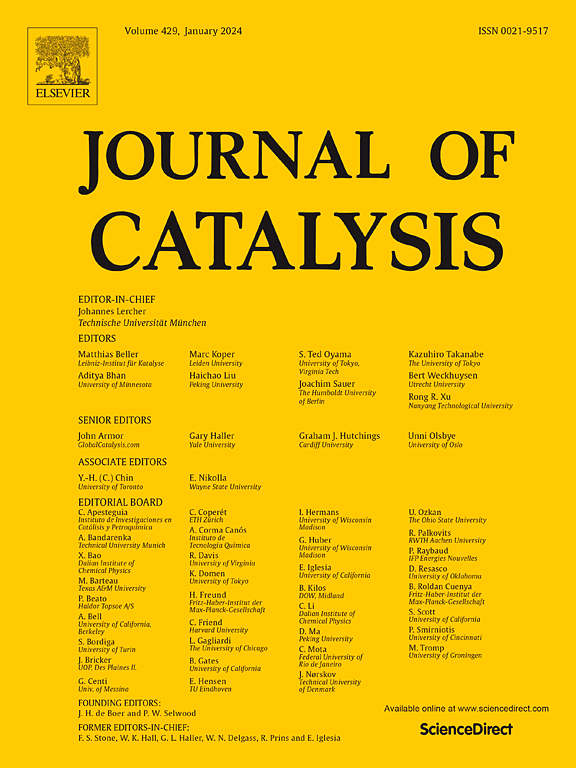多描述子引导构建了功能化mof中受挫Lewis对双活性位点的微环境,使其朝着催化加氢的Sabatier最优方向发展
IF 6.5
1区 化学
Q2 CHEMISTRY, PHYSICAL
引用次数: 0
摘要
金属有机骨架(mof)中活性位点可及性和化学性质的精确设计和调控对于提高催化性能至关重要,但也面临着重大挑战。本研究提出了一种具有受挫Lewis对(FLP)双活性位点的功能化MOF-808催化剂的设计策略。更具体地说,我们通过4类单羧酸配体(即6-取代BR2哌啶-2-羧酸(FLP1-R), 1-取代BR2吡唑-2-羧酸(FLP2-R), 5-取代BR2吡啶-2-羧酸(FLP3-R)和6-取代BR2吡啶-2-羧酸(FLP4-R))交换来调节Lewis酸碱位点(LA- lb)的微环境,其中LA的取代基(-R)为- H, -OH, -NH2, -CH3, - Br, - Cl, - F, -NO2, - CF3或-CN。利用密度泛函理论(DFT),阐明了影响催化性能的电子水平调控机制。我们建立了40个功能化mof的筛选原则,揭示了活性部分(中性FLP-R)的几何和电子结构与吸附能和吉布斯自由能势垒之间的线性关系。首次提出了多描述子、LA、LB与双活性位点(φc1-LB-LA-c2)上电子定位函数(ELF)临界点(c1和c2)之间的二面角、LA和LB的距离(DLA&;LB)和FLP-R的局部化学势(μL),以确定解离H2吸附优于化学吸附双环戊二烯(DCPD)的候选物质,从而减轻双活性位点的强结合。此外,由B原子(LA)和N原子(LB)的p带中心推导出的本构描述子|εpB|+|εpN||εpB|+|εpN|形成了一个倒火山状曲线,FLP3-CH3、FLP4-F、FLP4-CH3和FLP4-OH功能化MOF-808位于最优点,平衡H2解离和8,9-二氢双环戊二烯(8,9- dhdcpd)的加氢。我们的工作通过开发多描述符将催化剂的固有特性与其催化活性联系起来,为高性能MOF的设计铺平了道路。本文章由计算机程序翻译,如有差异,请以英文原文为准。


Multi-descriptors guided constructing the microenvironment of frustrated Lewis pair bi-active sites in functionalized MOFs toward Sabatier optimal for catalytic hydrogenation
Precise design and regulation of active site accessibility and chemical properties within metal–organic frameworks (MOFs) are crucial for enhancing catalytic performance, yet pose significant challenges. This study presents a design strategy for functionalized MOF-808 catalysts featuring frustrated Lewis pair (FLP) bi-active sites for catalytic hydrogenation. More specifically, we modulated the microenvironment of Lewis acid-base sites (LA-LB) by 4 categories of monocarboxylic acid ligands (i.e., the 6-substituted BR2 piperidine-2-carboxylic acid (FLP1-R), 1-substituted BR2 pyrazole-2-carboxylic acid (FLP2-R), 5-substituted BR2 pyrrolidine-2-carboxylic acid (FLP3-R) and 6-substituted BR2 pyridine-2-carboxylic acid (FLP4-R)) exchange, in which the LA coordinated the substituent group (−R) is −H, –OH, –NH2, –CH3, −Br, −Cl, −F, –NO2, −CF3, or –CN. Utilizing density functional theory (DFT), it elucidates the electronic-level regulation mechanisms affecting catalytic performance. We establish screening principles for 40 functionalized MOFs, revealing linear relationships between the geometric and electronic structures of the active moiety (neutral FLP-R) and both adsorption energy and Gibbs free energy barriers. Multi-descriptors, the dihedral angle between LA, LB and the critical points (c1 and c2) of electron localization function (ELF) upon dual active sites (φc1-LB-LA-c2), the distance of LA and LB (DLA&LB) and local chemical potential (μL) of FLP-R were firstly proposed to identify candidates favoring dissociative H2 adsorption over chemisorbed dicyclopentadiene (DCPD), thereby mitigating bi-active site due to strongly bound. Furthermore, the intrinsic descriptor derived by the p band center of B atom (LA) and N atom (LB) yield an inverted volcano-shaped curve, with FLP3-CH3, FLP4-F, FLP4-CH3, and FLP4-OH functionalized MOF-808 positioned at the optimal point, balancing H2 dissociation and the hydrogenation of 8,9-dihydrodicyclopentadiene (8,9-DHDCPD). Our work bridges the inherent characteristics of catalysts and their catalytic activities through the development of multi-descriptors, paving the way for high-performance MOF design.
求助全文
通过发布文献求助,成功后即可免费获取论文全文。
去求助
来源期刊

Journal of Catalysis
工程技术-工程:化工
CiteScore
12.30
自引率
5.50%
发文量
447
审稿时长
31 days
期刊介绍:
The Journal of Catalysis publishes scholarly articles on both heterogeneous and homogeneous catalysis, covering a wide range of chemical transformations. These include various types of catalysis, such as those mediated by photons, plasmons, and electrons. The focus of the studies is to understand the relationship between catalytic function and the underlying chemical properties of surfaces and metal complexes.
The articles in the journal offer innovative concepts and explore the synthesis and kinetics of inorganic solids and homogeneous complexes. Furthermore, they discuss spectroscopic techniques for characterizing catalysts, investigate the interaction of probes and reacting species with catalysts, and employ theoretical methods.
The research presented in the journal should have direct relevance to the field of catalytic processes, addressing either fundamental aspects or applications of catalysis.
 求助内容:
求助内容: 应助结果提醒方式:
应助结果提醒方式:


